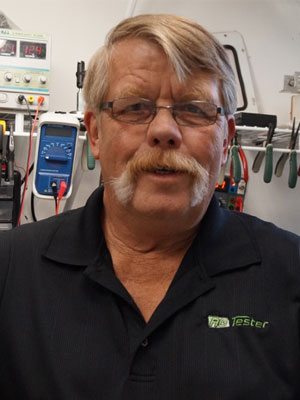
|
| Figure 1 |
As we continue in this series, the last connector might be the AMP connector. These were very popular years ago with Dickey-john radars, controllers and planter monitors and they are still used today along with some of the new versions from the same company.
Like all the others, I thought it would be easy to find and I was wrong even again. They are part of TE Connectivity. This link will take you to the Mouser page for AMP or Circular Connectors from TE Connectivity.
In agriculture, we are mostly using Series 1 connectors. Figure 1 shows the connectors from left to right, shell size 23, 17, 13 and 11. You’ll find the eleven series on Dickey- john Radars with 4 pins and shell size 23 on 37 pin planter monitor connectors.
I’m still not sure what the 11 to 23 shell size numbers mean. I use the size 13 for the primary connection to my Ag-Tester units. The 17 is used on the Raven 400 series controllers. It’s a solid connector that really is made to accommodate lots of connect and disconnect situations.
All the connections in the Series 1 connectors are 16 gauge connectors. That’s the same capacity as the Duetsch DT series and the basic Weather-Pack, along with the Metri-Pack 150 series and others in the same connector size range.
I could go on to the next and the next connector forever! Hopefully you’re getting a grip on how these connectors are packaged and sold while watching for the details. I’ve bought a LOT of connectors over the years because it was too expensive not to have the parts.
As soon as I thought I knew what I needed, I was wrong again. My last go-around with the wrong Conxall order from Mouser cost me another $100. Distributors that size won’t allow returns.
If you’re going to work with connectors, you’ll need tools. To simply remove the pins or sockets, you need a specific tool called a “pin extractor.” These are perfectly sized and shaped specific to a single type of connector.
They typically cost $15-$20. The DT series connectors from Deutsch have locking tabs inside the connector that are released with a small screwdriver.
Ratcheting crimpers work very nicely for attaching specific connectors very tightly to the wires. For years, my installation habit has been to try to pull the pin off the wire after installation. Pull hard.
You’re better off finding it is not tight enough before the cable goes back into service. These crimpers are connector specific and will cost $200-$300 or more.

|
| Figure 2 |
Soldering (Figure 2) the connection is another way to properly attach a pin or socket to a wire. Here there are two primary concerns: The tabs that mechanically attach the pin to the wire must be uniformly installed to insure the pin will still fit in the opening provided and lock in place and the shape must be accurate. The other issue is to insure the connection is soldered correctly using only rosin core solder.
Companies that build a lot of harnesses have automated crimpers and wire strippers. Pins and sockets come on a roll of 2,500 and the operator hits a foot switch to activate the machine.
We can’t wrap up this discussion without addressing the concerns of the manufacturers. The folks that create all the tools we have today in agriculture have a vested interest and concern in the accuracy and quality of their cables. Most don’t encourage field technicians the repair other than a complete cable replacement.
That can be very time consuming and expensive. Having all the replacement cables on hand can become very expensive and I’ve learned the hard way about the cost of obsolete inventory.
In the last few years as a Trimble Dealer, I was impressed to find complete wiring diagrams with connector pin-outs and connector ID information at their dealer Website. The information is there for troubleshooting help but was extremely helpful when connectors needed to be replaced.
Hopefully you have found the information in this series to be helpful. There are lots of sources for replacement connectors outside of the wholesale marketplace. You can use the Mouser or Digi-Key sites to identify the connector.
Then contact with an ag-supplier to actually buy what you need. Many times, kits contain all the parts needed. You’ll pay a little more at these suppliers, but you’ll get the right parts the first time and some can help with the wiring information.
Agri-Motive has been around for years and offers custom cables and connectors. Another supplier I’ve known is C&R Supply in South Dakota.
I like to use Ag-Express in Sulphur Springs, Ind. You can contact John Slavens and his group at 765-533-4809.
You can contact me at Ag Tester. Send me a couple photos of the valve or sensor and connector you’re working with and I’ll help you get it identified and the tools and parts you need.
Let me know what you’d like to see in future tech notes. The goal is to offer precision farming specialists the tools they need to effectively work in the field. I’ll look forward to hearing from you.
Jump to Other Articles in this Series:
- Overview of Common Connectors
- Conxall Connectors
- Weather-Pack Series
- Metri-Pack Series
- Making the Proper Connection (you are here)



![[Technology Corner] Helping Your Customers Determine Which Technology is Right for Them](https://www.precisionfarmingdealer.com/ext/resources/2025/03/26/Helping-Your-Customers-Determine-Which-Technology-is-Right-for-Them.png?height=290&t=1743084621&width=400)


